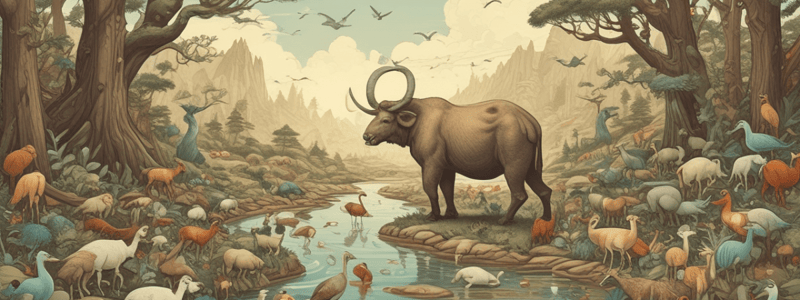Podcast
Questions and Answers
What is one factor that can affect the size of an individual animal?
What is one factor that can affect the size of an individual animal?
- Nutrition (correct)
- Competition
- Light
- Habitat
What is the likely outcome if an animal population has a decrease in food and water availability?
What is the likely outcome if an animal population has a decrease in food and water availability?
- Population size will increase
- Population size will fluctuate
- Population size will decrease (correct)
- Population size will remain the same
In which type of environment is life more likely to thrive with abundant food and prey?
In which type of environment is life more likely to thrive with abundant food and prey?
- Areas with high light intensity (correct)
- Deep sea vent communities
- Caves
- Arctic regions
What is one factor that influences the population size of animals in a particular habitat?
What is one factor that influences the population size of animals in a particular habitat?
Why do animal populations in tropical regions tend to be larger than those in arctic or desert regions?
Why do animal populations in tropical regions tend to be larger than those in arctic or desert regions?
What is the relationship between nutrition and population size?
What is the relationship between nutrition and population size?
Which of the following factors can affect the population size of animals in a particular region?
Which of the following factors can affect the population size of animals in a particular region?
What is the primary reason why arctic and desert communities have fewer resources to support larger populations?
What is the primary reason why arctic and desert communities have fewer resources to support larger populations?
What event occurred roughly 65 million years ago that led to the extinction of dinosaurs?
What event occurred roughly 65 million years ago that led to the extinction of dinosaurs?
What helped small mammals survive during the mass extinction event?
What helped small mammals survive during the mass extinction event?
What happens when competition for scarce resources is high between two populations?
What happens when competition for scarce resources is high between two populations?
What is the term for the cycle of a predator population increasing, followed by a decrease in its prey population, and then a decrease in the predator population?
What is the term for the cycle of a predator population increasing, followed by a decrease in its prey population, and then a decrease in the predator population?
Which type of symbiosis is characterized by one species benefiting and the other species being harmed?
Which type of symbiosis is characterized by one species benefiting and the other species being harmed?
What is the term for the interaction between two species where both species benefit?
What is the term for the interaction between two species where both species benefit?
What is likely to happen to an animal's population size if it is affected by parasitism?
What is likely to happen to an animal's population size if it is affected by parasitism?
Flashcards are hidden until you start studying
Study Notes
Nutrition and Population Size
- Poor nutrition during growth can lead to smaller body size in individuals and populations.
- Adequate nutrition is essential for larger population sizes.
- Inadequate nutrition can lead to smaller population sizes.
Light and Population Size
- More light generally means more abundant food and prey, leading to larger population sizes.
- Limited light can lead to smaller population sizes.
Habitat and Niche
- Different habitats support varying population sizes, with tropical regions often supporting larger populations than arctic or desert regions.
- The type of niche an animal occupies within a habitat can greatly impact population size.
- Access to nutrients is a critical factor in determining population size.
Competition and Predation
- High competition for resources can lead to declining population sizes or the growth of one population at the expense of another.
- Predation plays a crucial role in population size, with predators influencing prey populations and vice versa.
- The predator-prey cycle illustrates the dynamic relationship between predators and prey.
Symbiosis and Population Size
- Commensalism, where one species benefits without harming the other, has a minimal impact on population size.
- Parasitism, where one species benefits and the other is harmed, can significantly impact population size.
- Mutualism, where both species benefit, can lead to thriving populations for both species.
Studying That Suits You
Use AI to generate personalized quizzes and flashcards to suit your learning preferences.




